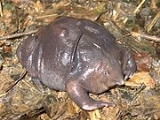
Sooglossidae
Encyclopedia
The Seychelles Frogs are a family
of frogs found on the Seychelles Islands
and India
. Until recently this family was believed to include the genera Nesomantis and Sooglossus, but following a major revision of amphibians in 2006 the genus Nesomantis was named a junior synonym of Sooglossus; conversely, the recently-discovered Purple Frog
which was initially assigned to a distinct monotypic
family (Nasikabatrachidae) is now included in the Sooglossidae.
All of the species are relatively small terrestrial frogs, about 4 centimetres (1.6 in) in length, hiding under fallen leaves or in rock crevices. They are unusual for the Neobatrachia
ls, in that they undertaking inguinal amplexus, a primitive version of amplexus
. They lay their eggs on moist ground, rather than in water. One species lacks tadpole
s, with the eggs hatching directly into froglets, while the others carry the tadpoles on their back until metamorphosis
.
There is no fossil record for the family. Ancestors diverged when the Seychelles Islands split from India about 100 million years BCE.
(1894-1940).
Family (biology)
In biological classification, family is* a taxonomic rank. Other well-known ranks are life, domain, kingdom, phylum, class, order, genus, and species, with family fitting between order and genus. As for the other well-known ranks, there is the option of an immediately lower rank, indicated by the...
of frogs found on the Seychelles Islands
Seychelles
Seychelles , officially the Republic of Seychelles , is an island country spanning an archipelago of 115 islands in the Indian Ocean, some east of mainland Africa, northeast of the island of Madagascar....
and India
India
India , officially the Republic of India , is a country in South Asia. It is the seventh-largest country by geographical area, the second-most populous country with over 1.2 billion people, and the most populous democracy in the world...
. Until recently this family was believed to include the genera Nesomantis and Sooglossus, but following a major revision of amphibians in 2006 the genus Nesomantis was named a junior synonym of Sooglossus; conversely, the recently-discovered Purple Frog
Purple Frog
Nasikabatrachus sahyadrensis is a frog species belonging to the family Sooglossidae. It can be found in the Western Ghats in India. Common names for this species are Purple Frog, Indian Purple Frog, Pignose Frog or Doughnut Frog. It was discovered by S.D. Biju and F...
which was initially assigned to a distinct monotypic
Monotypic
In biology, a monotypic taxon is a taxonomic group with only one biological type. The term's usage differs slightly between botany and zoology. The term monotypic has a separate use in conservation biology, monotypic habitat, regarding species habitat conversion eliminating biodiversity and...
family (Nasikabatrachidae) is now included in the Sooglossidae.
All of the species are relatively small terrestrial frogs, about 4 centimetres (1.6 in) in length, hiding under fallen leaves or in rock crevices. They are unusual for the Neobatrachia
Neobatrachia
Neobatrachia are a suborder of the Anura, the order of frogs and toads. This suborder is the most advanced and apomorphic of the three anuran orders alive today; hence its name, which literally means "new frogs"...
ls, in that they undertaking inguinal amplexus, a primitive version of amplexus
Amplexus
Amplexus is a form of pseudocopulation in which a male amphibian grasps a female with his front legs as part of the mating process...
. They lay their eggs on moist ground, rather than in water. One species lacks tadpole
Tadpole
A tadpole or polliwog is the wholly aquatic larval stage in the life cycle of an amphibian, particularly that of a frog or toad.- Appellation :...
s, with the eggs hatching directly into froglets, while the others carry the tadpoles on their back until metamorphosis
Metamorphosis
Metamorphosis is a biological process by which an animal physically develops after birth or hatching, involving a conspicuous and relatively abrupt change in the animal's body structure through cell growth and differentiation...
.
There is no fossil record for the family. Ancestors diverged when the Seychelles Islands split from India about 100 million years BCE.
Taxonomy
The family was first described in 1931 by Gladwyn Kingsley NobleGladwyn Kingsley Noble
Gladwyn Kingsley Noble was an American zoologist.- Works :*"American Egret at Martha's Vineyard, Mass" The Auk Vol. 31 N. 1: 100...
(1894-1940).
- Genus Sooglossus (Seychelles FrogSeychelles FrogThe Seychelles islands support six species of frog. Of these, one is introduced and five are endemic. This includes two endemic genera:Mascarene frog Ptychadena mascareniensis , Seychelles tree frog Tachycnemis seychellensis and four species of the Sooglossidae.The sooglossid frogs are considered...
s)- Gardiner's Seychelles FrogGardiner's Seychelles FrogGardiner's Frog is a small frog of the Sooglossidae family and endemic to the Seychelles.-Physical description:Gardiner's Frog is one of the smallest frogs in the world, reaching a maximum length of 11 millimetres . Newly hatched frogs measure only 3 millimetres in length. Adult males are only...
(S. gardineri) - Seychelles Palm FrogSeychelles Palm FrogThe Seychelles palm frog is so called because it is usually found hiding in the axils of palm trees. It is the most arboreal of the Sooglossidae and this makes detection difficult. As a result the palm frog is the most recent species of the family to have been discovered . More recently it is...
(S. pipilodryas) - Seychelles Frog (S. sechellensis)
- Thomasset's Frog (S. thomasseti)
- Gardiner's Seychelles Frog
- Genus Nasikabatrachus (Purple FrogPurple FrogNasikabatrachus sahyadrensis is a frog species belonging to the family Sooglossidae. It can be found in the Western Ghats in India. Common names for this species are Purple Frog, Indian Purple Frog, Pignose Frog or Doughnut Frog. It was discovered by S.D. Biju and F...
)- Nasikabatrachus sahyadrensis

